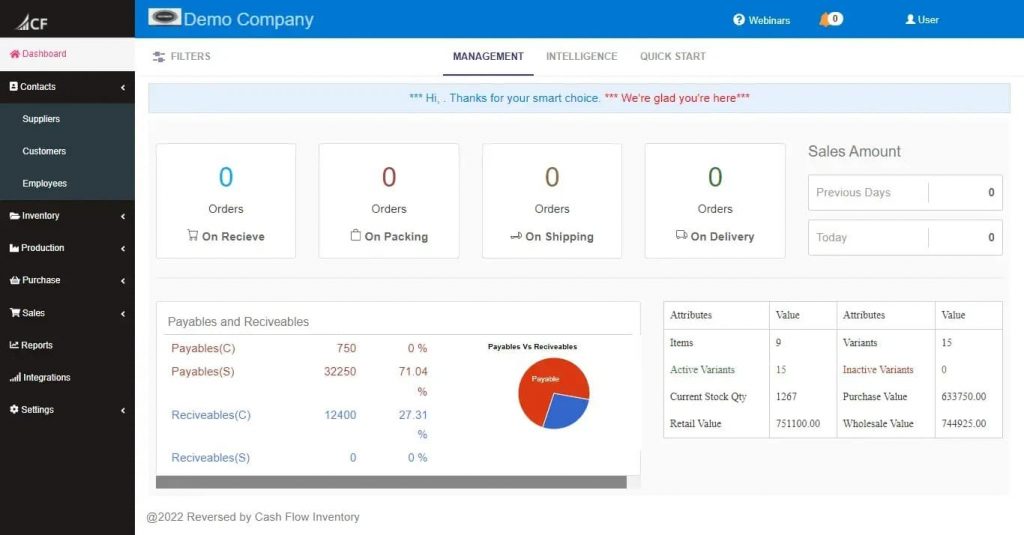Editorial Note: We are an inventory management software provider. While some of our blog posts may highlight features of our own product, we strive to provide unbiased and informative content that benefits all readers.
Inventory management stands as a crucial pillar of success. Inventory represents a significant portion of a grocery store’s assets, and its effective management directly impacts profitability, customer satisfaction, and operational efficiency. Striking a balance between overstocking and understocking is essential to optimize cash flow and prevent losses.
The perishable nature of grocery items introduces unique challenges to inventory management. The risk of shrinkage and spoilage looms large, making it imperative to accurately forecast demand and maintain real-time visibility into stock levels. Seasonal fluctuations, promotions, and unpredictable consumer behavior further complicate the task of predicting sales trends.

In this blog post, we delve deeper into the intricacies of inventory management for grocery stores, with a particular focus on cash flow inventory. We’ll explore the challenges, strategies, and technologies that can empower grocery store owners and managers to optimize their inventory management practices, enhance cash flow, and achieve their business goals.
The Importance of Inventory Management for Grocery Stores:
Inventory management plays a pivotal role in the success of grocery stores, influencing both financial performance and customer satisfaction. Effective inventory management practices can lead to a range of benefits, including:
- Improved Profitability: By optimizing inventory levels, grocery stores can minimize the costs associated with overstocking and understocking. Overstocking leads to excess storage costs, increased risk of spoilage and shrinkage, and the need for discounting to clear out excess stock. Understocking, on the other hand, results in lost sales opportunities and customer dissatisfaction.
- Enhanced Customer Satisfaction: When grocery stores maintain adequate stock levels of popular items, customers are more likely to find what they need, leading to a positive shopping experience. This, in turn, can foster customer loyalty and encourage repeat business.
- Optimized Cash Flow: Excessive inventory, the amount of capital tied up in unsold inventory, can significantly impact a grocery store’s financial well-being. By optimizing inventory, stores can free up capital for other investments, such as store renovations, marketing initiatives, or employee training.
- Reduced Operational Costs: Efficient inventory management can streamline ordering processes, minimize the need for manual stock counts, and improve overall warehouse organization. This can lead to reduced labor costs and improved operational efficiency.
- Enhanced Decision-Making: Inventory management systems provide valuable data and insights into sales trends, product movement, and supplier performance. This information can inform data-driven decision-making on purchasing, pricing, and promotional strategies.
Inventory management is not merely a logistical function; it is a strategic imperative for grocery stores to achieve sustainable profitability, customer satisfaction, and operational efficiency. By adopting effective inventory management practices, grocery stores can optimize their cash flow, reduce costs, and enhance their overall financial health.
Challenges and Complexities of Grocery Store Inventory Management:
Grocery store inventory management presents a unique set of challenges and complexities, stemming from the inherent nature of the industry and the dynamic market environment. These challenges can be broadly categorized into three areas:
1. Perishable Inventory and Shrinkage
The perishable nature of grocery items is a major challenge for inventory management. Products with limited shelf lives are susceptible to spoilage and shrinkage, leading to financial losses and reduced customer satisfaction. Effective inventory management practices must minimize the risk of spoilage by ensuring proper storage conditions, maintaining real-time visibility into stock levels, and implementing efficient ordering and rotation policies.
2. Demand Forecasting and Fluctuations
Accurately forecasting demand is crucial for grocery stores to optimize inventory levels and avoid stockouts or overstocking. However, demand patterns are often complex and influenced by various factors, including seasonal fluctuations, promotions, and unpredictable consumer behavior. Grocery stores must employ data analytics tools, historical sales data, and external market insights to make informed demand forecasts and adjust inventory levels accordingly.
3. Supply Chain Disruptions and Vendor Performance
Grocery stores rely on a complex supply chain network to deliver products from producers to their shelves. Disruptions in this network, such as natural disasters, transportation delays, or supplier issues, can lead to stockouts and inventory shortages. Effective inventory management practices should incorporate risk mitigation strategies to address potential supply chain disruptions and maintain reliable product availability.
In addition to these overarching challenges, grocery store inventory management is also complicated by factors such as:
- Product Variety and Assortment: Grocery stores offer a wide range of products with diverse shelf lives and demand patterns, making inventory management more intricate.
- Store Layout and Space Constraints: The physical layout of a grocery store can impact inventory management efficiency, particularly in optimizing product placement and stock rotation.
- Technology Adoption and Integration: Integrating inventory management systems with other enterprise systems, such as POS systems and supply chain management software, is crucial for real-time data visibility and streamlined operations.
To navigate these challenges and complexities, grocery stores must adopt a comprehensive inventory management strategy that encompasses demand forecasting, supply chain management, technology integration, and continuous improvement initiatives. By effectively managing their inventory, grocery stores can optimize their cash flow, reduce losses, enhance customer satisfaction, and achieve sustainable business growth.
Introducing Cash Flow Inventory:
In an inventory management and optimization software, Cash Flow Inventory serves as a critical tool for identifying excessive inventory, or capital tied up in unsold items that are not yet generating revenue for a grocery store. This aspect of inventory management directly impacts a store’s financial health and cash flow position.

Excess inventory can strain a grocery store’s financial resources in several ways:
- Reduced Liquidity: When capital is tied up in unsold inventory, it becomes less available for other essential expenses, such as paying suppliers, investing in store improvements, or covering operational costs.
- Increased Carrying Costs: Storing and maintaining unsold inventory incurs additional costs, such as storage fees, insurance, and the risk of spoilage and shrinkage.
- Missed Investment Opportunities: Excessive inventory limits a store’s ability to invest in growth initiatives, such as expanding product offerings, enhancing marketing campaigns, or improving customer service.
Optimizing inventory is essential for grocery stores to improve their financial performance and achieve long-term sustainability. By minimizing the amount of capital tied up in unsold inventory, stores can free up resources for more strategic investments, reduce carrying costs, and enhance overall cash flow.
Strategies for Optimizing Inventory in Grocery Stores:
Optimizing inventory is crucial for grocery stores to achieve financial stability, enhance profitability, and ensure long-term sustainability. By effectively managing the amount of capital tied up in unsold inventory, stores can free up resources for strategic investments, reduce carrying costs, and improve overall cash flow.
Effective inventory optimization strategies can be broadly categorized into three main areas:
- Demand Forecasting and Inventory Planning:
- Accurate Demand Forecasting: Employ data analytics tools, historical sales data, and external market insights to make informed demand forecasts and adjust inventory levels accordingly.
- Seasonal Fluctuation Management: Implement seasonal inventory management strategies to account for predictable fluctuations in demand. Increase stock levels for peak seasons and reduce them for off-peak periods.
- Promotion Planning and Inventory Optimization: Plan promotions carefully to avoid overstocking or understocking. Ensure adequate inventory levels for promoted items and closely monitor sales trends during promotions.
- Inventory Management and Stock Control:
- First-In, First-Out (FIFO) Method: Implement the FIFO method to ensure older stock is sold before newer stock, minimizing the risk of spoilage and shrinkage.
- Real-Time Inventory Visibility: Leverage technology solutions, such as inventory management software and barcode scanners, to track stock levels in real-time and maintain accurate records.
- Regular Inventory Audits: Conduct regular physical audits to identify discrepancies, prevent theft, and ensure accurate stock records.
- Product Placement and Rotation: Optimize product placement on shelves to facilitate easy stock rotation and minimize the risk of spoilage.
- Supply Chain Management and Vendor Collaboration:
- Supplier Selection and Negotiation: Establish strong relationships with reliable suppliers who can deliver products consistently and efficiently. Negotiate favorable payment terms to improve cash flow.
- Efficient Delivery Schedules: Collaborate with suppliers to establish efficient delivery schedules that minimize lead times and reduce inventory holding costs.
- Supply Chain Risk Mitigation: Implement risk mitigation strategies to address potential supply chain disruptions, such as natural disasters, transportation delays, or supplier issues.
In addition to these strategies, grocery stores can also consider implementing:
- Category Management: Analyze product performance by category to identify slow-moving or unprofitable items that may contribute to excessive inventory.
- Markdowns and Product Clearance: Implement markdown strategies for slow-moving items to reduce carrying costs and free up capital. Consider product clearance events to sell off excess inventory.
- Data-Driven Decision-Making: Utilize data analytics tools to gather insights into sales trends, product movement, and supplier performance. Use this data to inform inventory management decisions and identify areas for improvement.
By implementing these comprehensive inventory optimization strategies, grocery stores can effectively manage their inventory levels, optimize their financial performance, and achieve long-term success in the competitive grocery industry.
Conclusion:
Inventory management stands as a critical pillar of success for grocery stores, playing a pivotal role in optimizing cash flow, enhancing profitability, and ensuring customer satisfaction. Effective inventory management practices can lead to a range of benefits, including improved profitability, enhanced customer satisfaction, optimized cash flow, reduced operational costs, and enhanced decision-making.
Navigating the challenges and complexities of grocery store inventory management requires a comprehensive approach that encompasses demand forecasting, supply chain management, technology integration, and continuous improvement initiatives. By adopting effective inventory management strategies, grocery stores can effectively manage their inventory, optimize stock levels, and achieve sustainable financial growth.
In the dynamic and competitive world of grocery retail, inventory management is not merely a logistical function; it is a strategic imperative for success. By embracing effective inventory management practices, grocery stores can transform their inventory from a cost center to a profit driver, paving the way for long-term financial stability and sustainable growth.
Take a Quiz Test - Test Your Skill
Test your inventory management knowledge. Short multiple-choice tests, you may evaluate your comprehension of Inventory Management.
- It increases the reorder point
- It decreases the reorder point
- It has no impact on the reorder point
- It both increases and decreases the reorder point depending on the situation
